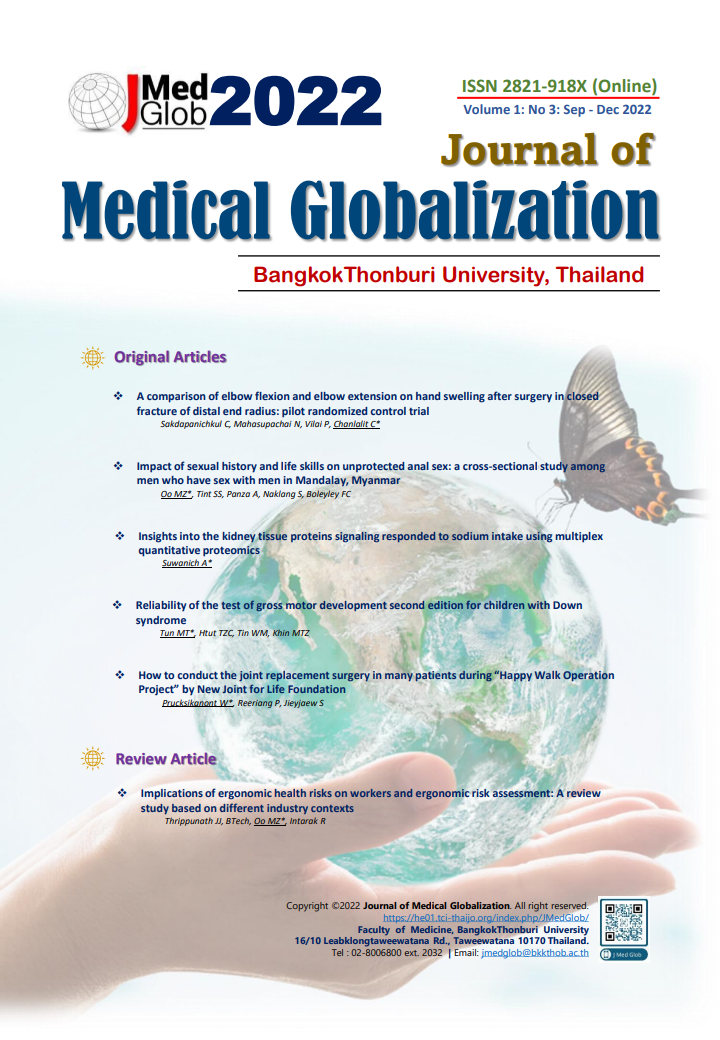Insights into the Kidney Tissue Proteins Signaling Responded to Sodium Intake Using Multiplex Quantitative Proteomics
คำสำคัญ:
Kidney tissue proteome, Sodium intakeบทคัดย่อ
Dietary sodium intake has been linked to the amount of kidney proteins in the body. High sodium intake can lead to an increase in the amount of proteins found in the kidneys, which can in turn lead to an increased risk of hypertension and other kidney-related health issues. In this study, the difference levels of sodium rat chow were used to alter rats' kidney tissue. Body weight was not affected by sodium intake. Urine volume was increased in high sodium group, and urine osmolality was decreased in low sodium intake compared to control. The homogenized kidney tissues were analyzed by multiplex quantitative proteomics. Quantitative analysis showed that total proteins data revealed 4054 proteins in kidney tissue at p<0.05. Among this, low sodium diet showed 259 significantly difference proteins compared to control. High sodium diet showed 357 significantly difference proteins compared to control. Protein-proteins interaction analysis showed the predominant signaling pathway are serine/threonine metabolism and proteins trafficking.
เอกสารอ้างอิง
FDA, U. S. F. D. (2022). Sodium in your diet. fda.gov Retrieved from https://www.fda.gov/food/nutrition-education-resources-materials/sodium-your-diet.
Abu-Sawwa, R., Dunbar, S. B., Quyyumi, A. A., & Sattler, E. L. P. (2019). Nutrition intervention in heart failure: should consumption of the DASH eating pattern be recommended to improve outcomes? Heart Fail Rev, 24(4), 565-573.
Kuehneman, T., Saulsbury, D., Splett, P., & Chapman, D. B. (2002). Demonstrating the impact of nutrition intervention in a heart failure program. J Am Diet Assoc, 102(12), 1790-1794.
Lennie, T. A., Moser, D. K., Biddle, M. J., Welsh, D., Bruckner, G. G., Thomas, D. T., Bailey, A. L. (2013). Nutrition intervention to decrease symptoms in patients with advanced heart failure. Res Nurs Health, 36(2), 120-145.
Fathima, K. A., & Bhargava, M. (2018). Salt Reduction and Low-sodium Salt Substitutes: Awareness among Health-care providers in Mangalore, Karnataka. Indian J Community Med, 43(4), 266-269.
Hussain, K., Murdin, L., & Schilder, A. G. (2018). Restriction of salt, caffeine and alcohol intake for the treatment of Meniere's disease or syndrome. Cochrane Database Syst Rev, 12(12), CD012173.
McLean, R. (2022). Low sodium salt substitutes: a tool for sodium reduction and cardiovascular health. Cochrane Database Syst Rev, 8(8), ED000158.
Cao, H., Zhang, A., Sun, H., Zhou, X., Guan, Y., Liu, Q., Wang, X. (2015). Metabolomics-proteomics profiles delineate metabolic changes in kidney fibrosis disease. Proteomics, 15(21), 3699-3710.
Dubin, R. F., & Rhee, E. P. (2020). Proteomics and Metabolomics in Kidney Disease, including Insights into Etiology, Treatment, and Prevention. Clin J Am Soc Nephrol, 15(3), 404-411.
Nishimura, M., Nanbu, A., Ohtsuka, K., Takahashi, H., Iwai, N., Kinoshita, M., & Yoshimura, M. (1997). Sodium intake regulates renin gene expression differently in the hypothalamus and kidney of rats. J Hypertens, 15(5), 509-516.
Delgado-Reyes, C. V., & Garrow, T. A. (2005). High sodium chloride intake decreases betaine-homocysteine S-methyltransferase expression in guinea pig liver and kidney. Am J Physiol Regul Integr Comp Physiol, 288(1), R182-187.
Kovarik, J. J., Morisawa, N., Wild, J., Marton, A., Takase-Minegishi, K., Minegishi, S., Titze, J. (2021). Adaptive physiological water conservation explains hypertension and muscle catabolism in experimental chronic renal failure. Acta Physiol (Oxf), 232(1), e13629.
van der Lubbe, N., Lim, C. H., Meima, M. E., van Veghel, R., Rosenbaek, L. L., Mutig, K., Hoorn, E. J. (2012). Aldosterone does not require angiotensin II to activate NCC through a WNK4-SPAK-dependent pathway. Pflugers Arch, 463(6), 853-863.
Ko, B., Mistry, A., Hanson, L., Mallick, R., & Hoover, R. S. (2015). Mechanisms of angiotensin II stimulation of NCC are time-dependent in mDCT15 cells. Am J Physiol Renal Physiol, 308(7), F720-727.
Pearce, D., Soundararajan, R., Trimpert, C., Kashlan, O. B., Deen, P. M., & Kohan, D. E. (2015). Collecting duct principal cell transport processes and their regulation. Clin J Am Soc Nephrol, 10(1), 135-146.
Lu, X., He, L., Zhou, Q., Wang, M., Shen, W. J., Azhar, S., Hu, Z. (2017). NHERF1 and NHERF2 regulation of SR-B1 stability via ubiquitination and proteasome degradation. Biochem Biophys Res Commun, 490(4), 1168-1175.
เผยแพร่แล้ว
รูปแบบการอ้างอิง
ฉบับ
ประเภทบทความ
สัญญาอนุญาต
ลิขสิทธิ์ (c) 2023 วารสารการแพทย์โลกาภิวัฒน์

อนุญาตภายใต้เงื่อนไข Creative Commons Attribution-NonCommercial 4.0 International License.








